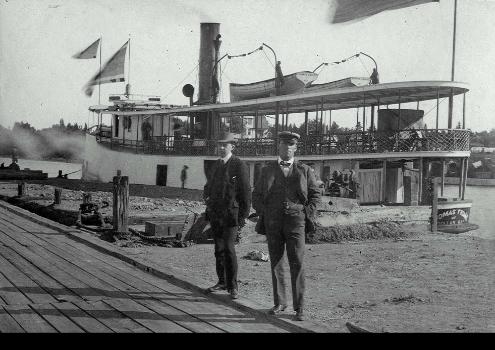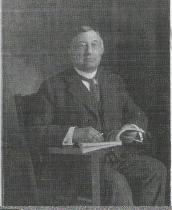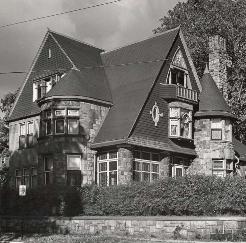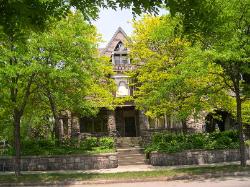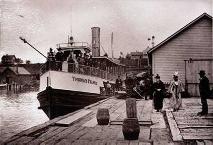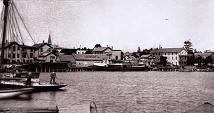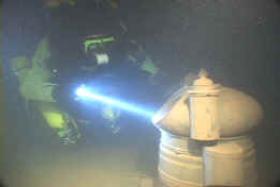
| Answer to Quiz #19 - July 23, 2005 Easy: Who is the boat named after? Medium: what body of water is it sitting in? Difficult: Where is the boat now? |
| Used by permission of Dale Niesen. Click on thumbnail to see a larger image. |
| Answers: Easy: Thomas Friant Medium: Dollar Bay, Houghton, Hancock, or another town along the Keweenaw Waterway, formerly known as Portage Lake and River Difficult: At the bottom of Lake Superior, 13 miles SSE of Two Harbors, MN, just off the Apostle Islands |
This has been our most popular quiz yet. We received many correct answers, along
with pictures, insights, historical notes, speculations. Of course, there are always those
answers from left field that make you laugh or scratch your head
We quote below from some of the great answers we received.
with pictures, insights, historical notes, speculations. Of course, there are always those
answers from left field that make you laugh or scratch your head
We quote below from some of the great answers we received.
Thomas Friant, Jr.
Thomas Friant, Sr., father of Thomas Friant Jr., came to Michigan in 1837 (the year
that marked the admission of the state to the Union), from Wayne Co., NY and he and
others slowly threaded their way through swamps and over Indian trails till they
reached the Grand river, at a point where now stands Portland, Ionia county. There
they built a raft and then floated down the river to the Baptist mission. On what is now
the site of the city of Grand Rapids, Mr. Friant decided to stop his wanderings and to
settle in what appeared to him a most desirable location. He was deeply impressed with
the extent and character of the vast pine forest through which he and his companions
had floated. He immediately began clearing the timber that covered the present site of
the city. In 1848 he built a saw mill on Rouge River, seven miles up from Grand
Rapids, and he continued in the lumber business until his death, in 1887. Of course his
son, Thomas Friant, Jr., reared in these surroundings, became interested in lumber, and
in the passing years he became one of the most prominent and influential
representatives of he lumber industry in Michigan.
Thomas Friant, Sr., father of Thomas Friant Jr., came to Michigan in 1837 (the year
that marked the admission of the state to the Union), from Wayne Co., NY and he and
others slowly threaded their way through swamps and over Indian trails till they
reached the Grand river, at a point where now stands Portland, Ionia county. There
they built a raft and then floated down the river to the Baptist mission. On what is now
the site of the city of Grand Rapids, Mr. Friant decided to stop his wanderings and to
settle in what appeared to him a most desirable location. He was deeply impressed with
the extent and character of the vast pine forest through which he and his companions
had floated. He immediately began clearing the timber that covered the present site of
the city. In 1848 he built a saw mill on Rouge River, seven miles up from Grand
Rapids, and he continued in the lumber business until his death, in 1887. Of course his
son, Thomas Friant, Jr., reared in these surroundings, became interested in lumber, and
in the passing years he became one of the most prominent and influential
representatives of he lumber industry in Michigan.
Thomas Friant [Jr.] was born in Plainfield, Kent
county, Michigan, February 16, 1840. In youth he
attended the district school, doing farm work also,
until at the age of 17 years he commenced teaching
school in the winter season. In 1858 he entered the
lumber office of Hopkins & Friant at Grand Haven,
where an elder brother was one of the firm, and
afterward was in the forwarding office of Galen
Eastman at the same place.
From 1862 to 1867 he was engaged in the business of
druggist, and held several town offices, among them
those of Justice of the Peace and Town Clerk. In
county, Michigan, February 16, 1840. In youth he
attended the district school, doing farm work also,
until at the age of 17 years he commenced teaching
school in the winter season. In 1858 he entered the
lumber office of Hopkins & Friant at Grand Haven,
where an elder brother was one of the firm, and
afterward was in the forwarding office of Galen
Eastman at the same place.
From 1862 to 1867 he was engaged in the business of
druggist, and held several town offices, among them
those of Justice of the Peace and Town Clerk. In
1869 he worked for Nelson, Comstock & Co. of Grand Rapids as book-keeper, and
also as book-keeper for Comstock & Wartrous. In 1870 he went into partnership with
Squier & White of Grand Haven and entered into contract with the Ottawa County
Boom Company to run, raft and deliver all logs on Grand River destined for Grand
Haven. In 1873 White & Friant renewed this contract and have conducted the business
ever since to the end, up to 1890, when they had no more to handle, the entire output of
the pine forests tributary to Grand River having "gone west."
Since 1879 the firm of White & Friant have also been engaged in the manufacture and
sale of pine lumber, under the different firm names of White, Friant & Co., White &
Friant Lumber Company, and White, Friant & Letellier. At present they are actively
engaged in manufacturing at Manistee and Menominee. Mr. Friant is a representative
of the active,pushing, enterprising and successful business men of Western Michigan.
Grand Rapids has been his home and headquarters during most of his business life. In
1924 Mr Friant was living in California, but still a resident of Grand Rapids, MI.
Submitted by Marilyn Hamilton-Stewart
from Baxter's 1891 History of Grand Rapids, MI
also as book-keeper for Comstock & Wartrous. In 1870 he went into partnership with
Squier & White of Grand Haven and entered into contract with the Ottawa County
Boom Company to run, raft and deliver all logs on Grand River destined for Grand
Haven. In 1873 White & Friant renewed this contract and have conducted the business
ever since to the end, up to 1890, when they had no more to handle, the entire output of
the pine forests tributary to Grand River having "gone west."
Since 1879 the firm of White & Friant have also been engaged in the manufacture and
sale of pine lumber, under the different firm names of White, Friant & Co., White &
Friant Lumber Company, and White, Friant & Letellier. At present they are actively
engaged in manufacturing at Manistee and Menominee. Mr. Friant is a representative
of the active,pushing, enterprising and successful business men of Western Michigan.
Grand Rapids has been his home and headquarters during most of his business life. In
1924 Mr Friant was living in California, but still a resident of Grand Rapids, MI.
Submitted by Marilyn Hamilton-Stewart
from Baxter's 1891 History of Grand Rapids, MI
Here is a link to Mr Friant's house in Heritage Hill in Grand Rapids, MI. Marilyn says
she has been through this house several times and it is the home of the former mayor.
http://www.heritagehillweb.org/Search/building.asp?id=61.
she has been through this house several times and it is the home of the former mayor.
http://www.heritagehillweb.org/Search/building.asp?id=61.
| The Thomas Friant House in 1969 (left) and in 2004 (above). |
The city of Friant, California (in Fresno County) was named after Thomas Friant, Jr.
He died in 1927 and is buried in Kent Co., MI.
He died in 1927 and is buried in Kent Co., MI.
FRIANT, CA
This point has been known by various names
since miners first visited in the 1850s. It has been
called Converse Ferry, Jones Ferry,
Hamptonville, and with the arrival of the railroad
was rechristened "Pollasky". The name came
from Marcus Pollasky, sent to Fresno by the
Southern Pacific Railroad, to promote a railroad
eastward from Fresno over the Sierras. The first
This point has been known by various names
since miners first visited in the 1850s. It has been
called Converse Ferry, Jones Ferry,
Hamptonville, and with the arrival of the railroad
was rechristened "Pollasky". The name came
from Marcus Pollasky, sent to Fresno by the
Southern Pacific Railroad, to promote a railroad
eastward from Fresno over the Sierras. The first
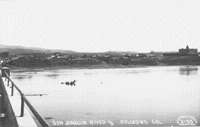
train ran October 1, 1892. Investors intended to turn the hamlet into a major city but
the planned improvements never materialized and Marcus Pollasky quietly departed
Fresno County. By 1921 it was called Friant after Thomas Friant, who with T. S.
White, father of the author Stewart Edward White, operated the White-Friant Lumber
Co.
the planned improvements never materialized and Marcus Pollasky quietly departed
Fresno County. By 1921 it was called Friant after Thomas Friant, who with T. S.
White, father of the author Stewart Edward White, operated the White-Friant Lumber
Co.
Where is the Thomas Friant docked?
Dollar Bay is a town located near Lake Superior in Upper Penisula, MI. Since the
Thomas Friant made stops at Dollar Bay as well as Houghton and Hancock, it is
reasonable to assume the location of the picture was one of these towns on the now
Keweenaw Waterway, previously known as the Portage River and Lake.
- Gail Garwood
The History of the Thomas Friant
The Thomas Friant was launched in 1884 in Grand Haven, Michigan and hauled
passengers along Lake Michigan for about fifteen years and after 1910 became a
commercial fishing boat. It sank in January 1924 near Two Harbors, Minnesota and is
presently still sitting about three hundred feet below the surface of Lake Superior. See
http://www.cdnn.info/industry/i040907a/i040907a.html.
Dale's photo shows bench seating along the railing and a number of folding chairs on
the stern deck, so it was apparently taken during the steamer's passenger days between
1884 and 1900. - George E. Wright
Dollar Bay is a town located near Lake Superior in Upper Penisula, MI. Since the
Thomas Friant made stops at Dollar Bay as well as Houghton and Hancock, it is
reasonable to assume the location of the picture was one of these towns on the now
Keweenaw Waterway, previously known as the Portage River and Lake.
- Gail Garwood
The History of the Thomas Friant
The Thomas Friant was launched in 1884 in Grand Haven, Michigan and hauled
passengers along Lake Michigan for about fifteen years and after 1910 became a
commercial fishing boat. It sank in January 1924 near Two Harbors, Minnesota and is
presently still sitting about three hundred feet below the surface of Lake Superior. See
http://www.cdnn.info/industry/i040907a/i040907a.html.
Dale's photo shows bench seating along the railing and a number of folding chairs on
the stern deck, so it was apparently taken during the steamer's passenger days between
1884 and 1900. - George E. Wright
| The Great Lakes Vessel Index Historical Collections of the Great Lakes Bowling Green State University http://digin.bgsu.edu/lakes.htm |
| ||||||||||||||||||||||||||||||||||||||||||||||||||||||||||||||||||||||||||||||||||||||||||||||||||||||||||||||||||||||
| ********** |
| The THOMAS FRIANT at the Emery Bros. Steamboat Dock at the foot of Mason Street. |
One of the most popular of the small steamers of the
Eighties and Nineties was the "THOMAS FRIANT,"
shown above in 1888, tied up at the Belvedere dock in
the upper channel. Obviously a special occasion, the
only clue to its meaning would be the presence of the
Ithaca K. of P. band, which might possibly have had
something to do with the formation of the local lodge
of the Knights of Pythias.
http://www.charlevoix.lib.mi.us/miles/III-001.htm
http://www.charlevoix.lib.mi.us/miles/III-005.htm
http://www.charlevoix.lib.mi.us/miles/III-007.htm
Eighties and Nineties was the "THOMAS FRIANT,"
shown above in 1888, tied up at the Belvedere dock in
the upper channel. Obviously a special occasion, the
only clue to its meaning would be the presence of the
Ithaca K. of P. band, which might possibly have had
something to do with the formation of the local lodge
of the Knights of Pythias.
http://www.charlevoix.lib.mi.us/miles/III-001.htm
http://www.charlevoix.lib.mi.us/miles/III-005.htm
http://www.charlevoix.lib.mi.us/miles/III-007.htm
| The Thomas Friant in the Harbor |
The Shipwreck
The Thomas Friant was a passenger steamer - converted to fishing tug - converted to
coastal steamer then back to fishing tug. The Friant was launched in 1884 in Grand
Haven, Mich., to carry tourists between Lake Michigan resorts. After near destruction
by fire at the Soo in Dec, 1908, the 96-foot boat was converted to haul cargo and for
commercial fishing. It sank off the Apostle Islands in water 305 feet deep 13 miles
south of Two Harbors in mid-lake out of Knife River in Lake Superior.
The vessel was bought by several men from Bayfield, Wis. They were fishing on Lake
Superior on Jan. 6, 1924, when heavy ice holed the wooden hull. Its nine-man crew
rowed a lifeboat through a frigid night and survived to tell a harrowing tale. A single
crewman scaled an icy cliff to reach an isolated homestead to seek help. The wreck was
identified in June 2004. - D. Dineen
The ship was built by Duncan Robertson in Grand Haven in 1884. She was 101.6'
long, 18' wide, and 15' long. Captain Einar Miller was her final owner. In June 2004, a
diving team from Minnesota including shipwreck hunting team discovered lying in 305’
of water in perfect shape in mid-lake out of Knife River.
Experts say the find itself - not to mention the condition of the ship - is rare. “"We were
amazed. It's so intact," said Jerry Eliason, a longtime diver who lives in Scanlon. His
search team includes Smith, Randy Beebe, of Duluth, and Ken Merryman, of Fridley.
Eliason's son, Jarrod Eliason of Colorado Springs, Colo., designed the torpedo-looking
side-scan sonar that first detected the ship.
The Thomas Friant was a passenger steamer - converted to fishing tug - converted to
coastal steamer then back to fishing tug. The Friant was launched in 1884 in Grand
Haven, Mich., to carry tourists between Lake Michigan resorts. After near destruction
by fire at the Soo in Dec, 1908, the 96-foot boat was converted to haul cargo and for
commercial fishing. It sank off the Apostle Islands in water 305 feet deep 13 miles
south of Two Harbors in mid-lake out of Knife River in Lake Superior.
The vessel was bought by several men from Bayfield, Wis. They were fishing on Lake
Superior on Jan. 6, 1924, when heavy ice holed the wooden hull. Its nine-man crew
rowed a lifeboat through a frigid night and survived to tell a harrowing tale. A single
crewman scaled an icy cliff to reach an isolated homestead to seek help. The wreck was
identified in June 2004. - D. Dineen
The ship was built by Duncan Robertson in Grand Haven in 1884. She was 101.6'
long, 18' wide, and 15' long. Captain Einar Miller was her final owner. In June 2004, a
diving team from Minnesota including shipwreck hunting team discovered lying in 305’
of water in perfect shape in mid-lake out of Knife River.
Experts say the find itself - not to mention the condition of the ship - is rare. “"We were
amazed. It's so intact," said Jerry Eliason, a longtime diver who lives in Scanlon. His
search team includes Smith, Randy Beebe, of Duluth, and Ken Merryman, of Fridley.
Eliason's son, Jarrod Eliason of Colorado Springs, Colo., designed the torpedo-looking
side-scan sonar that first detected the ship.
For more information, see:
http://www.smithdiving.com/newsevents/news_nwl.html
http://www.mnhs.org/places/nationalregister/shipwrecks/list.html
http://www.cdnn.info/news/article/a041220.html
http://www.lakesuperior.com/online/274/274jrnl.html
http://www.glsps.org/dive-past/program.htm
http://krypton.mnsu.edu/~dljavens/05%20News%20Letter.htm
http://www.smithdiving.com/newsevents/news_nwl.html
http://www.mnhs.org/places/nationalregister/shipwrecks/list.html
http://www.cdnn.info/news/article/a041220.html
http://www.lakesuperior.com/online/274/274jrnl.html
http://www.glsps.org/dive-past/program.htm
http://krypton.mnsu.edu/~dljavens/05%20News%20Letter.htm
A diver views the Friant compass binnacle.
http://www.glsps.org/dive-past/program.htm
http://www.glsps.org/dive-past/program.htm
Final Note: Some of our readers tired to identify the two men on the dock. The best
guess is that they are the owner and the captain of the boat, but we can't be sure. But
we do know that it is probably not Mr. Friant. If George E. Wright is correct, and the
picture was taken between 1884 and 1900, Mr. Friant would have been at lesat 44
years old. He would be too old to be the man on the right, and his facial features do not
match the man on the left.
guess is that they are the owner and the captain of the boat, but we can't be sure. But
we do know that it is probably not Mr. Friant. If George E. Wright is correct, and the
picture was taken between 1884 and 1900, Mr. Friant would have been at lesat 44
years old. He would be too old to be the man on the right, and his facial features do not
match the man on the left.
Congratulations to our winners!
Alice Hix Brad Potts Richard Kantz
Suzan Farris Gail Garwood Marvin Fretwell
Nancy Lowinger Betsy Scott Paul
Lisa Stahlberg Don Haase Meri West
Dee Levister Diane Levine Heather Haase
Lynne Perez Bridgette DiBenedetto Bob Nacnudduncan
June Evans Gus Janssen Gary Rice
D. Dineen Robert E. McKenna George E. Wright
Marilyn Hamill-Stewart Julie McCormick
Rosemary McMasters Hannah Readdick
Anthony Smart
If I have left your name off the list, please let me know. It was unintentional.
Alice Hix Brad Potts Richard Kantz
Suzan Farris Gail Garwood Marvin Fretwell
Nancy Lowinger Betsy Scott Paul
Lisa Stahlberg Don Haase Meri West
Dee Levister Diane Levine Heather Haase
Lynne Perez Bridgette DiBenedetto Bob Nacnudduncan
June Evans Gus Janssen Gary Rice
D. Dineen Robert E. McKenna George E. Wright
Marilyn Hamill-Stewart Julie McCormick
Rosemary McMasters Hannah Readdick
Anthony Smart
If I have left your name off the list, please let me know. It was unintentional.
| If you enjoy our quizzes, don't forget to order our book! Click here. |
If you have a picture you'd like us to feature a picture in a future quiz, please
email it to us at CFitzp@aol.com. If we use it, you will receive a free analysis of
your picture. You will also receive a free Forensic Genealogy CD or a 10%
discount towards the purchase of the Forensic Genealogy book.
email it to us at CFitzp@aol.com. If we use it, you will receive a free analysis of
your picture. You will also receive a free Forensic Genealogy CD or a 10%
discount towards the purchase of the Forensic Genealogy book.
| Quiz #19 Answer |
